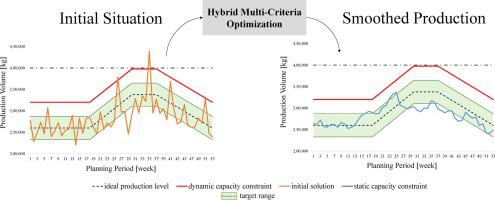当前位置:
X-MOL 学术
›
Comput. Ind. Eng.
›
论文详情
Our official English website, www.x-mol.net, welcomes your feedback! (Note: you will need to create a separate account there.)
An Efficient Hybrid Multi-Criteria Optimization Approach regarding Rolling Production Smoothing of a European Food Manufacturer
Computers & Industrial Engineering ( IF 7.9 ) Pub Date : 2020-09-01 , DOI: 10.1016/j.cie.2020.106620 Felix Kamhuber , Thomas Sobottka , Bernhard Heinzl , Jan Henjes , Wilfried Sihn
Computers & Industrial Engineering ( IF 7.9 ) Pub Date : 2020-09-01 , DOI: 10.1016/j.cie.2020.106620 Felix Kamhuber , Thomas Sobottka , Bernhard Heinzl , Jan Henjes , Wilfried Sihn

|
Abstract This paper introduces an innovative method for multi-objective optimization-based production planning with a rolling horizon for food manufacturing. It features a combination of a heuristic mixed-integer optimization and a metaheuristic optimization. The food industry is characterized by highly fluctuating demand, due to standard and promotion sales volumes, with large periodic variations, resulting in negative impacts on production. State-of-the-art multi-objective solution methods fail to address these complex fluctuations adequately, mainly due to the lack of modelling detail and optimization fine-tuning, i.e. details concerning part-goals and actuating variables. Furthermore, these methods contain static constraints rendering the planning unable to adapt the production system to seasonal (off-) peaks in demand and to consider resource adjustments. In contrast, the presented approach features dynamic capacity-based restrictions and dynamic stock-levels within a given planning horizon. The product volumes are split into sub-dimensions, each with product-specific constraints. In addition to a smoothed production, mid-term stock-levels, setup-costs and the utilization of downstream equipment – evaluated via a deterministic simulation – are optimized simultaneously. The results show a ~40% reduced output variation rate of cost- and labor-intensive key production equipment and a ~430% reduced capacity requirement for downstream equipment.
中文翻译:

一种关于欧洲食品制造商轧制生产平滑的高效混合多标准优化方法
摘要 本文介绍了一种基于多目标优化的具有滚动视野的食品制造生产计划的创新方法。它结合了启发式混合整数优化和元启发式优化。食品行业的特点是需求波动大,受标准和促销量影响,周期性波动较大,对生产造成负面影响。最先进的多目标求解方法未能充分解决这些复杂的波动,主要是由于缺乏建模细节和优化微调,即有关部分目标和致动变量的细节。此外,这些方法包含静态约束,使计划无法使生产系统适应季节性(非)需求高峰并考虑资源调整。相比之下,所提出的方法在给定的规划范围内具有基于动态容量的限制和动态库存水平。产品量分为多个子维度,每个子维度都有特定于产品的限制。除了平稳的生产之外,中期库存水平、设置成本和下游设备的利用率(通过确定性模拟进行评估)同时得到优化。结果表明,成本和劳动密集型关键生产设备的输出变化率降低了约 40%,下游设备的产能需求降低了约 430%。所提出的方法在给定的规划范围内具有基于动态容量的限制和动态库存水平。产品量分为多个子维度,每个子维度都有特定于产品的限制。除了平稳的生产之外,中期库存水平、设置成本和下游设备的利用率(通过确定性模拟进行评估)同时得到优化。结果表明,成本和劳动密集型关键生产设备的产量变化率降低了约 40%,下游设备的产能要求降低了约 430%。所提出的方法在给定的规划范围内具有基于动态容量的限制和动态库存水平。产品量分为多个子维度,每个子维度都有特定于产品的限制。除了平稳的生产之外,中期库存水平、设置成本和下游设备的利用率(通过确定性模拟进行评估)同时得到优化。结果表明,成本和劳动密集型关键生产设备的输出变化率降低了约 40%,下游设备的产能需求降低了约 430%。通过确定性模拟评估的设置成本和下游设备的利用率同时优化。结果表明,成本和劳动密集型关键生产设备的产量变化率降低了约 40%,下游设备的产能要求降低了约 430%。通过确定性模拟评估的设置成本和下游设备的利用率同时优化。结果表明,成本和劳动密集型关键生产设备的输出变化率降低了约 40%,下游设备的产能需求降低了约 430%。
更新日期:2020-09-01
中文翻译:

一种关于欧洲食品制造商轧制生产平滑的高效混合多标准优化方法
摘要 本文介绍了一种基于多目标优化的具有滚动视野的食品制造生产计划的创新方法。它结合了启发式混合整数优化和元启发式优化。食品行业的特点是需求波动大,受标准和促销量影响,周期性波动较大,对生产造成负面影响。最先进的多目标求解方法未能充分解决这些复杂的波动,主要是由于缺乏建模细节和优化微调,即有关部分目标和致动变量的细节。此外,这些方法包含静态约束,使计划无法使生产系统适应季节性(非)需求高峰并考虑资源调整。相比之下,所提出的方法在给定的规划范围内具有基于动态容量的限制和动态库存水平。产品量分为多个子维度,每个子维度都有特定于产品的限制。除了平稳的生产之外,中期库存水平、设置成本和下游设备的利用率(通过确定性模拟进行评估)同时得到优化。结果表明,成本和劳动密集型关键生产设备的输出变化率降低了约 40%,下游设备的产能需求降低了约 430%。所提出的方法在给定的规划范围内具有基于动态容量的限制和动态库存水平。产品量分为多个子维度,每个子维度都有特定于产品的限制。除了平稳的生产之外,中期库存水平、设置成本和下游设备的利用率(通过确定性模拟进行评估)同时得到优化。结果表明,成本和劳动密集型关键生产设备的产量变化率降低了约 40%,下游设备的产能要求降低了约 430%。所提出的方法在给定的规划范围内具有基于动态容量的限制和动态库存水平。产品量分为多个子维度,每个子维度都有特定于产品的限制。除了平稳的生产之外,中期库存水平、设置成本和下游设备的利用率(通过确定性模拟进行评估)同时得到优化。结果表明,成本和劳动密集型关键生产设备的输出变化率降低了约 40%,下游设备的产能需求降低了约 430%。通过确定性模拟评估的设置成本和下游设备的利用率同时优化。结果表明,成本和劳动密集型关键生产设备的产量变化率降低了约 40%,下游设备的产能要求降低了约 430%。通过确定性模拟评估的设置成本和下游设备的利用率同时优化。结果表明,成本和劳动密集型关键生产设备的输出变化率降低了约 40%,下游设备的产能需求降低了约 430%。



























 京公网安备 11010802027423号
京公网安备 11010802027423号